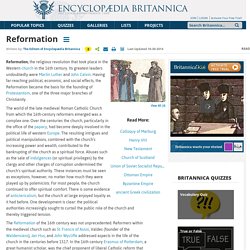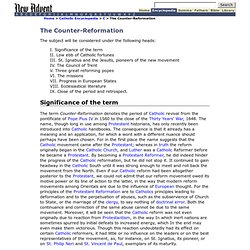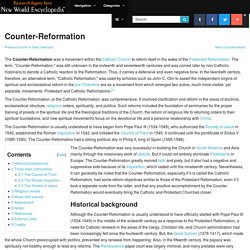

Reformation (Christianity. Reformation, the religious revolution that took place in the Western church in the 16th century.

Its greatest leaders undoubtedly were Martin Luther and John Calvin. Having far-reaching political, economic, and social effects, the Reformation became the basis for the founding of Protestantism, one of the three major branches of Christianity. The world of the late medieval Roman Catholic Church from which the 16th-century reformers emerged was a complex one.
Over the centuries the church, particularly in the office of the papacy, had become deeply involved in the political life of western Europe. Protestant Reformation. Although the core motivation behind these changes was theological, many other factors played a part, including the rise of nationalism, the Western Schism which eroded people's faith in the Papacy, the corruption of the Curia, and the new learning of the Renaissance which questioned much traditional thought.

On a technological level the invention of the printing press proved extremely significant in that it provided the means for the rapid dissemination of new ideas. The Roman Catholic Church responded with a Counter-Reformation initiated by the Council of Trent and spearheaded by the new order of the Society of Jesus (Jesuits) specifically organized to counter the Protestant movement. In general, Northern Europe, with the exception of most of Ireland, turned Protestant. Southern Europe remained Roman Catholic, while Central Europe was a site of fierce conflict, escalating to full-scale war.
Religious situation in Europe[edit] History and origins[edit] Earlier schisms[edit] Literacy[edit] THE REFORMATION. The Counter-Reformation. The subject will be considered under the following heads: I.

Significance of the term II. Low ebb of Catholic fortunes III. St. Ignatius and the Jesuits, pioneers of the new movement IV. Significance of the term The term Counter-Reformation denotes the period of Catholic revival from the pontificate of Pope Pius IV in 1560 to the close of the Thirty Years' War, 1648. Another point to be noticed is that, though we assign certain dates for the beginning and end of the period under consideration, there has never been any break in the striving of the Church against the heresies which arose in the sixteenth century. The span of time during which this enthusiasm lasted may be justly considered as an historical period, and it is that which we call the period of the Counter-Reformation.
Low ebb of Catholic fortunes "From the time of St. Germany Poland "Poland is in almost as hopeless a state. " France and Spain "The disorders in France and Spain are too well known for me to speak of them. " Counter-Reformation. The Counter-Reformation was a movement within the Catholic Church to reform itself in the wake of the Protestant Reformation.

The term, "Counter-Reformation," was still unknown in the sixteenth and seventeenth centuries and was coined later by non-Catholic historians to denote a Catholic reaction to the Reformation. Thus, it carries a defensive and even negative tone. In the twentieth century, therefore, an alternative term, "Catholic Reformation," was used by scholars such as John C. Olin to assert the independent origins of spiritual and ecclesiastical reform in the pre-Tridentine era as a movement from which emerged two active, much more visible, yet separate, movements: Protestant and Catholic Reformations.[1] The Counter-Reformation, or the Catholic Reformation, was comprehensive. The Counter-Reformation was very successful in building the Church in South America and Asia mainly through the missionary work of Jesuits. Historical background Three main instruments. Counter-Reformation. A copy of the Vulgate (the Latin edition of the Catholic Bible) printed in 1590, after many of the Council's reforms had begun to take place in Catholic worship.

The Counter-Reformation (also the Catholic Revival[1] or Catholic Reformation) was the period of Catholic revival beginning with the Council of Trent (1545–1563) and ending at the close of the Thirty Years' War (1648), and was initiated in response to the Protestant Reformation. The Counter-Reformation was a comprehensive effort composed of four major elements: Ecclesiastical or structural reconfigurationReligious ordersSpiritual movementsPolitical dimensions Council of Trent[edit] A session of the Council of Trent, from an engraving. Pope Paul III (1534–1549) initiated the Council of Trent (1545–1563), a commission of cardinals tasked with institutional reform, addressing contentious issues such as corrupt bishops and priests, indulgences, and other financial abuses.